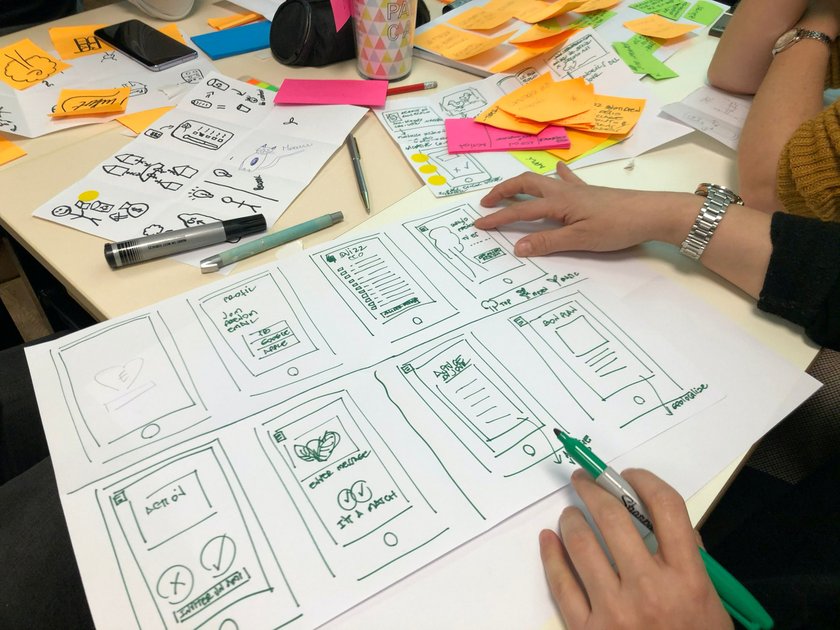Steps of Design Thinking: Unleashing the Power to Solve Problems
July 10, 2023

As individuals, we face a multitude of issues regularly. However, we rarely create solutions that genuinely prioritize the needs of each individual. This realization catalyzed the birth of the design process mindset, which aims to fill this gap and revolutionize the way we're trying to solve challenges by putting human needs first.
Many of us wonder why it is sometimes necessary to think like a designer when your job process involves completely different aspects. In fact, it's quite simple. We live in a world where one task replaces another, sometimes even before you have had time to learn the right skill. If your team's goal is not just to get another day's work done, but to create something of real value, then everyone must think like a designer, from the developer to the tester, from the marketer to the product owner.
To create convenient and useful products and services, you need to understand the needs of those for whom they are intended. Design thinking steps can help you dive deep into the customer experience, ask the right questions, and apply creative solutions. By understanding a few simple stages, anyone can apply design thinking methods to find creative solutions and solve problems that surround us in our businesses. So, let's get to the bottom of this!
By the way, Luminar Neo photo editor proves to be an exceptional software companion in the steps of design thinking for photographers. With its powerful features and intuitive interface, you can seamlessly bring your photo project to life and evaluate it for continuous improvement.
Steps to Design Thinking: What Is This?
Say you're tasked with organizing your office space to improve collaboration among team members. Where do you start? There are many possible solutions, but when you use unusual thinking, you don't focus on theory, colors, charts, and floor plans. You begin with people (for example, the individuals who will be working in the office and actively collaborating).
 Who are these people? What special demands do they have? A developer may need a second monitor and a larger desk. Someone who works with documents needs a filing cabinet. A person who interacts with the team wants a seat with a good view, closer to the board. What is their work schedule and how much overlap is there? Do these people go out to lunch, or do they shake sandwich crumbs out of their keyboards at the end of the week? You have to think about every employee in that room.
Who are these people? What special demands do they have? A developer may need a second monitor and a larger desk. Someone who works with documents needs a filing cabinet. A person who interacts with the team wants a seat with a good view, closer to the board. What is their work schedule and how much overlap is there? Do these people go out to lunch, or do they shake sandwich crumbs out of their keyboards at the end of the week? You have to think about every employee in that room.
So, such a mindset is a solution-finding practice that focuses on understanding and addressing human needs and challenges in a creative and empathetic way. It encourages multidisciplinary collaboration and iterative processes to arrive at innovative and human-centered decisions. This method is characterized by an emphasis on empathy, experimentation, and a deep understanding of the problem space.
Why Do We Need to Use Design Thinking Process Steps?
Perhaps you have not yet decided whether you need to use this technique specifically in your work process. There are several reasons why such thinking is valuable and why we need it:
- It puts human needs, wants, and experiences at the center of the problem-solving process. By empathizing with users, understanding their perspectives, and involving them throughout the process, such a mindset helps create products that truly address their concerns and improve their lives.
- This practice fosters a mindset of exploration, curiosity, and divergent thinking. It encourages generating a wide range of ideas and embracing unconventional approaches. This sparks innovation and enables the discovery of breakthrough decisions that may not emerge through traditional problem-solving methods.
- A design mindset encourages collaboration among people with different backgrounds, expertise, and perspectives. By bringing together people from various disciplines, it harnesses collective intelligence and enables holistic problem-solving. And with Luminar Neo's AI photo editing, designers can create compelling visual narratives and enhance presentations to tell a cohesive and engaging story.
- All steps in design thinking recognize that solving complex problems often requires multiple refinements. It provides a structured framework for testing and iterating ideas, incorporating feedback, and continuously improving solutions. This iterative process allows for rapid learning, adaptation, and optimization.
- Through active listening, observing, and engaging users throughout the process, such thinking helps gain deep insights and develop projects that resonate with the target audience. By the way, if you need to combine multiple images for a project, you can use Panorama Photo Stitcher or check out our blog for other options.
 In addition, by engaging people in previous stages and iteratively testing prototypes, this method reduces the risk of developing products or services that don't meet user needs or fail in the marketplace. It gives a structured approach for validating assumptions, gathering feedback, and making informed decisions, ultimately leading to better outcomes and reducing the risk of costly failures.
In addition, by engaging people in previous stages and iteratively testing prototypes, this method reduces the risk of developing products or services that don't meet user needs or fail in the marketplace. It gives a structured approach for validating assumptions, gathering feedback, and making informed decisions, ultimately leading to better outcomes and reducing the risk of costly failures.
What Are the Steps in the Design Thinking Process?
The main goal of this mindset is to create products and services that improve people's lives, break the rules, and change the situation. Classic market tools are not appropriate here because it is not enough to ask the customers what they want. After all, they may not know.
In the past, the role of design was purely tactical — to improve what was already there. Today's creative mindset is proactive. The potential solutions are not found somewhere or waiting to be discovered; they are encapsulated in the creativity that the team realizes. This is the kind of thinking that requires originality. Such a process consists of several iterative steps that encourage empathy, creative thinking, and collaboration.
We can also apply such mindset principles to explore innovative ways to auto-edit photos. For instance, Luminar Neo allows you to transform an ordinary picture into a masterpiece with an expertly edited sky.
1. User Research: Putting Yourself in the Client's Shoes
The first stage is to empathize with the people who experience the problem or the users for whom the product is being developed. This involves researching, interviewing, observing, and immersing yourself in the users' environment to gain deep insight into their needs, wants, and challenges.
 Based on the research and data synthesis, create user personas and empathy maps. This involves fictional representations of typical users, including their characteristics, goals, behaviors, and pain points. Empathy maps are visual depictions of users' thoughts, feelings, actions, and aspirations. These tools help develop a shared understanding of the target audience and build empathy for their needs.
Based on the research and data synthesis, create user personas and empathy maps. This involves fictional representations of typical users, including their characteristics, goals, behaviors, and pain points. Empathy maps are visual depictions of users' thoughts, feelings, actions, and aspirations. These tools help develop a shared understanding of the target audience and build empathy for their needs.
2. Defining the Problem: Refining the Challenge
 Once you have a comprehensive understanding of the users and their needs, the next step is to define the problem statement or design challenge. This involves synthesizing the information gathered, identifying patterns, and distilling the core issues to create a clear and concise problem statement.
Once you have a comprehensive understanding of the users and their needs, the next step is to define the problem statement or design challenge. This involves synthesizing the information gathered, identifying patterns, and distilling the core issues to create a clear and concise problem statement.
3. Ideation: Generating Creative Ideas
The ideation phase focuses on generating a wide range of creative ideas. It's a divergent thinking stage where brainstorming sessions, ideation workshops, and other creative techniques are used to encourage free thinking, encourage wild thoughts, and explore different possibilities without judgment. The quantity of ideas is emphasized over quality in this stage.
 For example, there is a very interesting method. Instead of looking for good ideas and putting yourself under pressure, call out the worst concepts your team can come up with. This removes any fear and confidence issues and allows people to be more playful and entrepreneurial because they know their ideas won't be judged harshly.
For example, there is a very interesting method. Instead of looking for good ideas and putting yourself under pressure, call out the worst concepts your team can come up with. This removes any fear and confidence issues and allows people to be more playful and entrepreneurial because they know their ideas won't be judged harshly.
4. Testing and Feedback: Iterating and Refining the Solution
One of the most important steps of design thinking is to test the prototypes with users or stakeholders. The goal is to gather feedback and insights on the proposed ideas. Testing helps validate assumptions, uncover unforeseen challenges, and identify areas for improvement. User feedback is valuable for making informed decisions about the direction of the design.
 Based on the insights gained during the testing phase, the next move is to refine and iterate the design. This may involve going back to earlier stages and repeating the process several times to further improve the solution. Each iteration aims to address identified issues, improve the user experience, and better align the product with user needs and expectations.
Based on the insights gained during the testing phase, the next move is to refine and iterate the design. This may involve going back to earlier stages and repeating the process several times to further improve the solution. Each iteration aims to address identified issues, improve the user experience, and better align the product with user needs and expectations.
5. Implementation: Bringing the Project to Life
Once the design has been refined and validated through multiple iterations, it's time to move to implementation. This phase involves developing a detailed execution plan, coordinating with stakeholders, and preparing the solution for launch or deployment. It may involve working with engineers, developers, marketers, and other relevant teams to bring the design to life.
 And once you have a selection of potential solutions, it's time to create low-fidelity prototypes. These are tangible representations or simulations of your ideas that allow you to test, iterate, and refine your concepts.
And once you have a selection of potential solutions, it's time to create low-fidelity prototypes. These are tangible representations or simulations of your ideas that allow you to test, iterate, and refine your concepts.
Prototypes can range from rough sketches to physical models, storyboards, or even interactive digital models, depending on the nature of the problem and the resources available. By the way, during the development of some prototypes, you may need software for image post-processing. And Skylum's online photo editor Luminar Neo can help you with that.
Advanced yet easy-to-use photo editor
Get Luminar Neo Now6. Evaluation and Continuous Improvement
After the product is implemented or launched, the design thinking process doesn't stop. The final step is to evaluate the success of the solution and gather feedback from users to measure its impact. This evaluation helps to identify areas for improvement, gather insights for future iterations, and measure the effectiveness of the design mindset against the desired outcomes.
 Sometimes all it takes to achieve perfection is a little tweak. For example, you can dramatically change the look of a photo with just one tool. Visit our blog to find creative presets for Lightroom.
Sometimes all it takes to achieve perfection is a little tweak. For example, you can dramatically change the look of a photo with just one tool. Visit our blog to find creative presets for Lightroom.
How to Apply This Mindset to Your Business?
If you search for "steps design thinking", you will find a lot of useful info, but not all articles describe exactly how to apply all these stages to your work. To bring such thinking to your organization or team, you can follow several practices that will make it easier to implement:
- Promote a culture of education and intentional practice by integrating creative thinking skills into daily tasks. Use small exercises throughout the day to encourage the application of unfamiliar principles. Also, proactively enroll team members in design thinking courses so they can continue to develop their skills.
- Encourage transparency and openness when discussing mistakes. In the course of many feedback sessions, it is inevitable to address instances where things did not go as planned. You can also encourage and embrace mistakes as valuable learning opportunities that pave the way for better decisions.
- Adopt the mindset of a skilled journalist, where active listening, thoughtful questioning, and impartiality are key. Simply expand your conversations beyond your immediate team or direct reports to engage with individuals from different perspectives. In doing so, you can uncover the real issues or questions that need to be addressed.
- Set clear expectations for feedback loops within your team. Communicate that you will actively engage in frequent testing and iteration to maximize results. By setting these expectations, you create a culture that values continuous improvement and recognizes feedback as a valuable tool for success.
When you introduce these four actionable steps to your team, this mindset becomes a catalyst for impactful change and meaningful results. Encourage your teammates to adopt this mindset and witness the remarkable results it can bring.
 When we all understand the customer's needs, don't get distracted by time and money, try to help the user, and build a dialog around that task, then we speak the same language. Ideas evolve in the same direction and a great product is formed.
When we all understand the customer's needs, don't get distracted by time and money, try to help the user, and build a dialog around that task, then we speak the same language. Ideas evolve in the same direction and a great product is formed.
The Bottom Line
Today, such a mindset is a necessity for such projects and products, where innovations and changes are constantly taking place, where a constant flow of new ideas and creative solutions is required. A project that uses all of the steps described above is always superior to competitors who systematically copy each other. Moreover, such non-standard thinking allows us to be ahead and set trends, to occupy and maintain leading positions in the market.
FAQ
What Are the Key Steps in the Design Mindset?
Key steps in this process include empathizing with people, defining the problem, generating potential solutions, prototyping ideas, testing, and iterating to create innovative and user-centered products.
How Does Empathy and User Research Contribute to Such Thinking?
These are crucial components of this approach because they provide a comprehensive understanding of people's needs, wants, and challenges. By delving into users' perspectives and experiences, valuable insights are gained that enable the creation of products that are not only more meaningful but also more effective in meeting clients' specific requirements.
Why Is Evaluation and Continuous Improvement Important?
Such elements are essential to design thinking because they allow for the evaluation of solutions, the identification of areas for improvement, and iterative refinement. This iterative approach ensures that projects evolve and adapt to better meet user needs over time.






